#afterburner II
Text
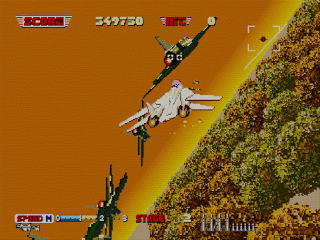
#cw flashing#cw epilepsy#cw motion sickness#gaming#arcade#sega#afterburner#afterburner ii#afterburner 2#retro gaming#80s#gif
23 notes
·
View notes
Text




Going to try and start posting these more regularly - I call them "Pinball Pairings" — like a fine wine paired with a chef-prepared meal, an Arcade title you know and love with its thematic counterpart. The first entry in the Pinball Pairings series:

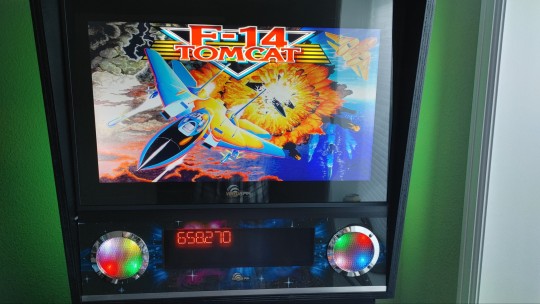
Afterburner II - Sega / 1987
+
F-14 Tomcat - Williams / 1987
The movie Top Gun was released in theaters in 1986. Coincidence? A little bit of trivia - the first game where "Come here!!" - the famous Mortal Kombat / Scorpion quote can be heard is actually the F-14 Tomcat pinball table - also created by the one and only Steve Ritchie!
Love to hear any feedback / comments / requests. Hope you like my MAME cab + Virtual Pin setup
#Pinball pairings#Afterburner#Afterburner ii#Afterburner 2#Sega#Arcade#f 14 tomcat#Williams pinball#Pinball#Top gun#Steve Ritchie#mortal kombat#Scorpion#Come here#yu suzuki
21 notes
·
View notes
Text
#365DaysOfVGM Day 116:
After Burner (After Burner; “After Burner II” AFTER BURNER [with MELODY] version, including the FM Towns version, the PC Engine version, and the “Bayonetta” After Burner [∞/Infinity Climax Mix] version [1987/1989/1990/2009])
Rushed description, but I don’t know how to go over each version of a track this long and well-made without having played the game myself! So I’ll just give up and say this one’s cool the whole way through, alright?
You got 4 different kinds of cool to choose from here, from the original, to the Electric Guitars and Horns of the FM Towns version, to the chiptune-feel of PC Engine’s, to a rather popular version made for Bayonetta which no doubt brought a resurgence of attention to the original as well!
For extra context I suppose, After Burner II was released just a year after OutRun, another Sega arcade game with famous music back then, although it seems this one wasn’t considered as genre-defining as OutRun’s ended up being, but that’s no reason to keep it overlooked.
And lastly, might as well add this since it’s SUPER recent, but the hard workers at Sega of America unionizing is a cool thing that I never expected to happen, I hope for the best in their goals and values!
(Length before loop [All]: 5+ minutes)
youtube
youtube
youtube
youtube
#After Burner II#AfterBurner II#after burner#afterburner#bayonetta#arcade#arcade games#playstation 3#ps3#sony playstation 3#xbox 360#x360#365daysofvgm#youtube#Youtube
1 note
·
View note
Text
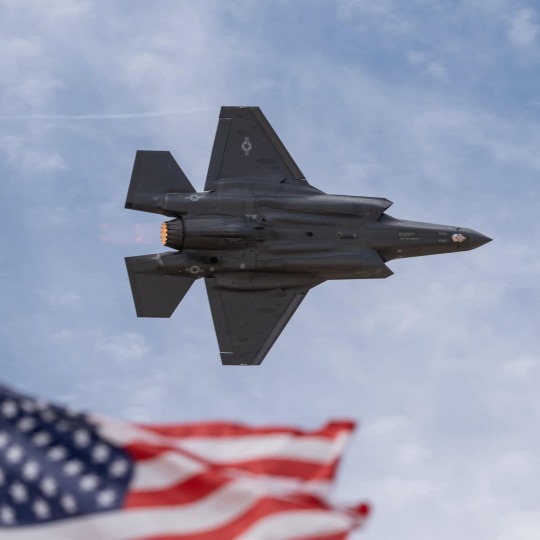
F-35 Demo practice at Davis-Monthan AFB
#Lockheed#F-35#Lightning II#Stealth#Fighter#Military#F-35 Demo#aviation#aircraft#jet#airplane#flying#USAF#F-35A#Afterburner
98 notes
·
View notes
Text
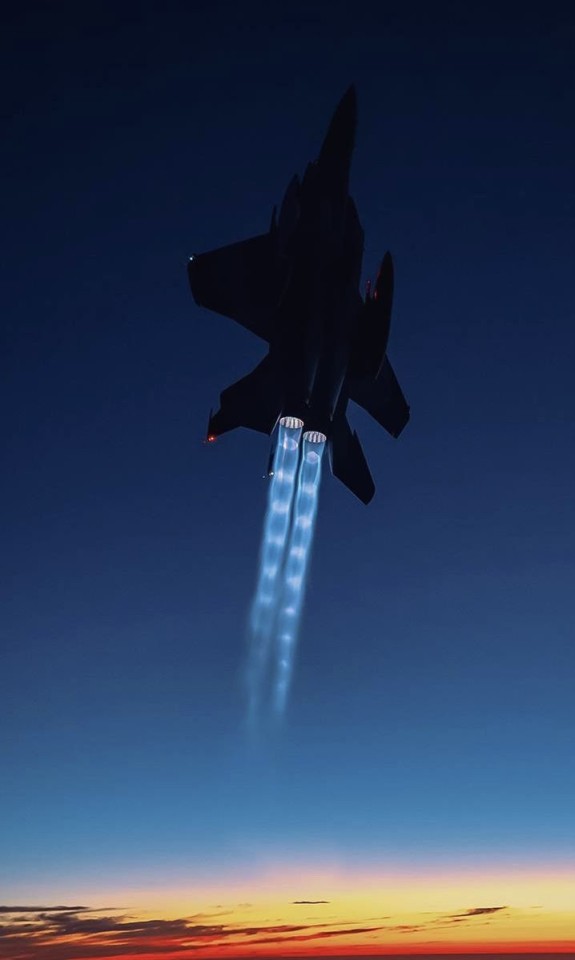
F-15E STRİKE EAGLE
687 notes
·
View notes
Photo

360 notes
·
View notes
Text

The F-35 kicking on the afterburner! The massive F135 engine looks incredible during sunset demos!
.
The 2023 Sun 'n Fun Air Show
Lakeland, Florida
#afterburner f35 f35lightning lockheedmartin prattandwhitney jet fighterjet airforce airshow aviation airplane canon photography#photography#pictureoftheday#canon#canonphotography#photooftheday#airshow#sigmalens#canonrebelt6i#canoneosr#aviationphotography#f 35#f 35 lightning ii#f 35a#jetengine#jet#jetfighter#fighter jet#fighter#airplane#aviation#plane#engine#flame#afterburner#afterburn#fast#Vapor
5 notes
·
View notes
Text
The Golden Age of the Video Game Arcade: 1987
The Golden Age of the Video Game Arcade: 1987
Welcome back to 1987, with this year’s long list of classic arcade games being impossible to detail in a single article. Here are some of my favourites.
1987 was a turning point for me and my fascination with the video game arcade. It had been a place of comfort for a good chunk of my young life, but with the arrival of the Sega Master System, home gaming (and in particular World Soccer and…

View On WordPress
#AfterBurner#Airwolf#APB#Bionic Commando#Combat School#Double Dragon#Game#Green Beret#Heavyweight Champ#Karnov#Operation Wolf#R-Type#Sega#Shinobi#Street Fighter#Street Fighter II#StreetFighter I#video game#Video Game Arcade#Wonder Boy - Monster Land#Xybots
1 note
·
View note
Text

Nimbumon Level- Baby I Type- Slime
A small digimon formed from weather data. It appears most commonly high in the sky, condensing from stray data and floating on the breeze until they digivolve.
Breeze Blower- a soft gust that serves as more of an escape mechanism than an attack

Turbimon Level- Baby II Type- Slime
A mechanised baby Digimon whose turbines grant it exceptional speed. However, it lacks control and often crashes into other Digimon ('𝘡𝘰𝘰𝘮 𝘒𝘢𝘣𝘰𝘰𝘮').
Zoom Kaboom- Flies straight towards the enemy and rams them hard with its helmet

JetHawkmon Level- Child Type- Chick
A small bird-type Digimon whose wings are not developed enough to fly. Instead, it uses the jetpack on its back to shoot across the sky at high speeds (𝘚𝘰𝘯𝘪𝘤 𝘗𝘦𝘤𝘬).
Sonic Peck- Spins while flying at high speeds to generate a ‘drill’ of air pressureTomoHawk- Shoots rings of wind from the engines of its jetpack

Peregrimon Level- Adult Type- Bird
It soars through the skies at almost 600mph, groups attacking any Digimon who enter their territory with military formations.
Its main attack is 𝘝𝘦𝘭𝘰𝘤𝘪𝘵𝘢𝘤𝘬𝘭𝘦, a high-speed ram that pierces the enemy's armour.
Velocitackle- Flies at high enough speeds to pierce stone with its beakWarhawk- Flaps its wings to shoot blades of wind that slice through foes
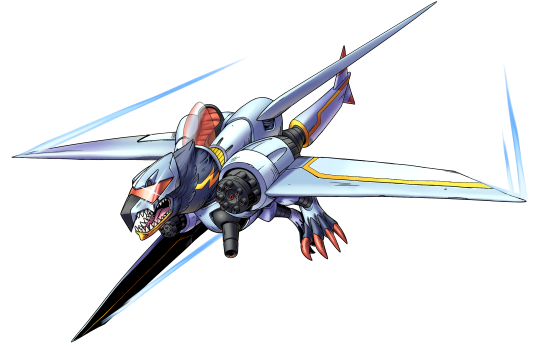
HiPeregrimon Level- Perfect Type- Machine Bird
A Peregrimon species that has upgraded using data from military specs. It now reaches speeds of 1500mph. Its 𝘔𝘢𝘤𝘩 10 𝘵𝘺𝘱𝘩𝘰𝘰𝘯 attack pierces the enemy with a hypersonic blitz while firing its tornado guns.
Typhoon- Fires its ‘Tornado’ shoulder-mounted machineguns while spinning with over 50 gs worth of pressureEagliser- Uses the spinning speed of its Tornado guns to create whirlwinds that slice foes with blades of air

BomberPeregrimon Level- Ultimate Type- Machine Bird
A Griffon-like Digimon that is the pinnacle of aerial technology. It now reaches speeds nearing Mach 10, and the 𝘎𝘪𝘨𝘢𝘯𝘵 𝘗𝘪𝘦𝘳𝘤𝘦𝘳 claws on its wings rend through all in its path.
Gigant Piercer- Rips through enemy digimon with the claws on its wings
Speed Blitz- Increases speeds to Mach 10 and bombards the opponent with claws, guns and afterburner jetsPeregrine Falchion- Spins every part of its body to generate a storm of wind blades that shred through anything in their path
80 notes
·
View notes
Text
Recommendations
Call of duty, MW2
@gh0st5bby4life fics are *chef's kiss*
Jitters : 141 x OC (Jitters is a PMC brought onto the support 141 operations, much to the distaste of the 141 group of PMC's)
@halcyone-of-the-sea's every work
Ghost :
Can't trust me ?
@uselsshuman 's Masterlist
he tells me to shut up, i got this
The choices we make
Angsty shit with Simon
The truth is out
Living with ghosts
Sugar Daddy
@nsharks 's one shots + Bleeding blue series
I'm with you
Keep you close
Butterfly effects
Wolf and the lamb - (Lion and the Lamb prequel)
One night stand leads to pregnancy
@charnelhouse's Ghost Masterlist
He knows
Mistaken friendship
No more
Protector
Mausoleum
All Alone
The things I never said
Dad!Simon by @lundenloves
Paperwork
Between dreams and sugar
Alpha!Ghost x reader
Protected
The witch and witch hunter
Mary on a cross
Werewolf!Simon x reader
I can't marry you
Menage
Sassy series
Situationship with firefighter!ghost
The little things
The roommate series
Cowards always run
Open his eyes
Accidentally hurting you
Others
One, two, three - Ghost x reader x soap
It's time to have fun - Ghost x reader x soap
Don't touch my boys - Ghost x reader x soap
Afterburn - 141 x F!reader
That sex pollen fic - everyone x reader
Dead Disco - Ghost x Soap x F!reader
COD monster men
The Pack
Poly relationship with Simon and Johnny
Safeword with the cod boys
Knights in shining tactical gear - Ghost x reader x soap
John Price :
All I need
Deep Breaths
Four
Lion and the Lamb
Viper and the Lamb
Argument and makeup
The Killing Moon
Professor Price
Rest
Bad dreams
Trust me
Apollo, do you copy
Imagine
What's so great about war ?
Songs that sound like sea foam - Fisherman!John Price x Mermaid!reader
Not in your life
Guilt
Bloodstained honesty
John Price x F!OC Tank
Salt and pepper
The Last of Us
@guess-my-next-obsession's Joel Masterlist
@charnelhouse's Joel Masterlist
Confused Warmth
You came back for me
Reject me, I get it
Who are you if not alone
Cold as ice (part 2 : Cold as ice II)
Savior complex
Too late
Summer Lovin
Say it with your hands
Hot single dilfs in your area want to chat!
You're losing me
Chasing
The Hayloft
Still here
The whole @pedgeitopascals Joel Miller masterlist
Call my name
Love in the middle of a firefight
Lucky for me, I run on spite and sweet revenge
Once again in your arms
Angst with Joel Miller
Narcos
Boss - Javier Pena x DEA!OC
The Rookie
The dangers of misunderstanding
To sell your love for peace
Just dumb enough to try
@absurdthirst's Javier Pena Masterlist
Are you staying ?
Just Friends
The last goodbye
Love me not
Haikyuu
All I wanna do is save you - Dilf!Matsukawa x College F!Reader
#simon riley x reader#joel miller x reader#captain price x reader#simon ghost riley x reader#141 x reader#cod fic#javier pena x reader
195 notes
·
View notes
Text
The Original Crew of Gemini 9


"Portrait of the Gemini 9 prime and backup crews. Seated are the Prime crew consisting of Astronauts Elliot M. See Jr. (left), command pilot, and Charles A. Bassett II, pilot. Standing are the backup crew consisting of Astronauts Thomas P. Stafford (left), command pilot, and Eugene A. Cernan, pilot."
The original prime crew of Gemini 9 (GT-9) was to be Elliot M. See Jr., command pilot, and Charles A. Bassett II, pilot. They were a part of NASA Astronaut Group 2 "New Nine" and Group 3 "The Fourteen", respectively, and this would have been their first spaceflight. On February 28, 1966, about four months before their scheduled May 17 spaceflight, they and the backup crew flew in two T-38s from Houston, Texas to St. Louis, Missouri. They were there for two weeks of simulator training for rendezvous and docking procedures, and to inspect their Gemini spacecraft at the McDonnell Aircraft plant.

"See and Bassett flew in one Northrop T-38A Talon jet trainer, tail number NASA 901 (Air Force serial number 63-8181), with See at the controls and Bassett in the rear seat. A second T-38, NASA 907, carried Stafford and Cernan in the same configuration. Weather at Lambert Field in St. Louis was poor, with rain, snow, and fog, broken clouds at 800 ft (240 m) and a cloud ceiling of 1,500 ft (460 m), requiring an instrument approach. When the two aircraft emerged below the clouds shortly before 9 am, both pilots realized that they had missed the outer marker and overshot the runway.
See then elected to perform a visual circling approach, a simplified landing procedure allowing flight under instrument rules, as long as the pilot can keep the airfield and any preceding aircraft in sight. The reported weather conditions at the airport were adequate for this type of approach, but visibility was irregular and deteriorating rapidly. Stafford began to follow See's plane, but when he lost sight of it in the clouds.

Astronaut Elliot M. See Jr. inside Gemini Static Article 5 spacecraft prior to water egress training in the Gulf of Mexico.
"As See and Bassett’s jet vanished from sight, Stafford barked to Cernan in his backseat: 'Goddammit, where’s he going?' It was the last they ever saw of their comrades."
"Stafford instead followed the standard procedure for a missed approach and pulled his aircraft up, back into the clouds for another attempt at an instrument landing.
See completed a full circle to the left at an altitude of 500 to 600 ft (150 to 180 m), and announced his intention to land on the southwest runway (24). With landing gear down and full flaps, the plane dropped quickly but too far left of the runway. See turned on his afterburner to increase power while pulling up and turning hard right. Seconds later, at 8:58 a.m. CST, the plane struck the roof of McDonnell Building 101 on the northeast side of the airport. It lost its right wing and landing gear on impact, then cartwheeled and crashed in a parking lot beyond the building which was in use as a construction staging area."


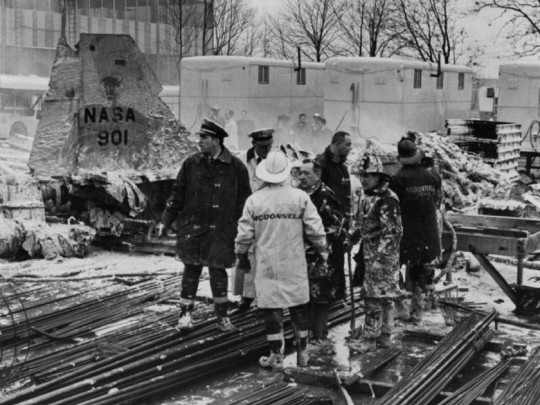
"The wreckage of their T-38 training jet, covered with firefighting foam. The jet clipped the roof of Building 101 with its right wing, then skipped twice along the roof before plunging into a construction yard nearby and exploding."
Both astronauts died instantly from trauma sustained in the crash. Inside Building 101, 17 McDonnell employees and contractors received mostly minor injuries from falling debris. The crash set off several small fires inside the building, and caused minor flooding from broken pipes and sprinklers. Stafford and Cernan didn't see the crash and made an instrument landing 14 minutes later. They were asked by the control tower, “Who was in NASA 901?” Stafford replied back “See and Bassett." They were told that McDonnell Aircraft Corp. had a message for them. "A few minutes later, as Stafford opened his canopy, there was James McDonnell ('Mr. Mac' himself, aviation pioneer and founder of McDonnell Aircraft Corp.) waiting for them. In solemn tones, he explained that See and Bassett were dead."
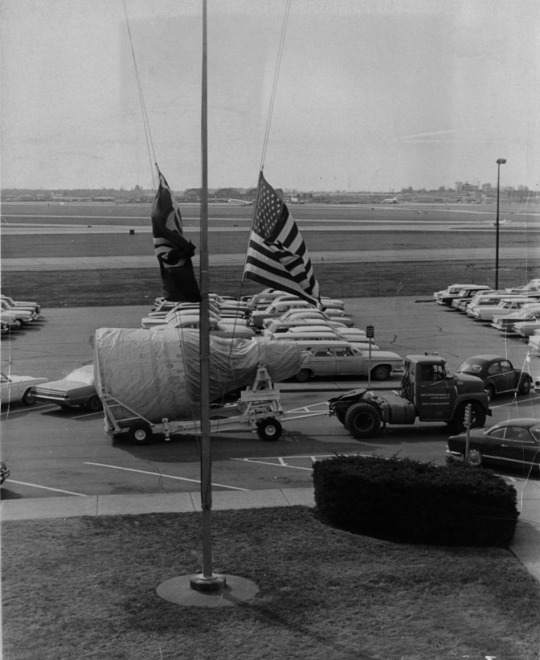
"A truck slowly pulls the Gemini IX capsule past flags at half staff at a McDonnell parking lot on March 2, 1966, in memory of the two astronauts who were to have flown it into space."
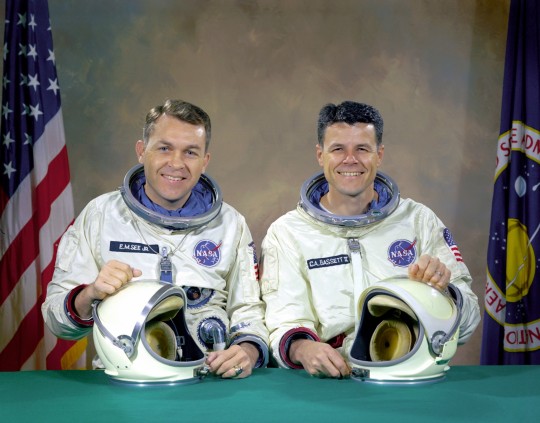
See, 38, had been a civilian test pilot and the married father of two girls. Bassett, 34, an Air Force pilot, left a wife, a daughter and a son.
"Alan Shepard and Deke Slayton flew to St. Louis to lead an investigation. Their closed investigative hearing was held in Building 101. On May 27, their report cited deteriorating weather conditions and a descent that was too steep for See to pull out."
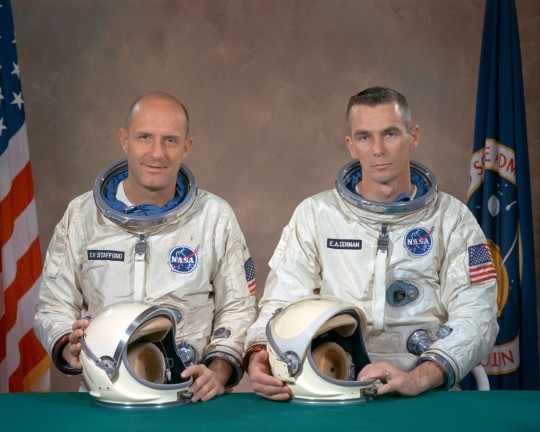
The backup crew, Thomas P. Stafford (left), command pilot, and Eugene A. Cernan, pilot.
"The promotion of Stafford and Cernan from backup to prime crew meant that a new backup crew was required. Jim Lovell and Buzz Aldrin were originally the backup crew for Gemini 10. This is significant as the standard crew rotation meant that a spot on the backup crew of Gemini 10 would have placed Buzz Aldrin on the prime crew of the non-existent mission after Gemini 12 (the crew rotation usually meant that after serving on a backup crew, an astronaut could expect to skip two missions and then be on a prime crew). Being moved up to the backup crew of Gemini 9 meant that Aldrin flew as part of the prime crew on Gemini 12, which played a major part in his selection for the Apollo 8 backup and Apollo 11 prime crews, ultimately making him the second human on the Moon."
-Information from Wikipedia: link, link
NASA ID: S66-15620, S66-28075, S66-15622, S66-15621, S65-28456
source, source
#GT-9#GT-IX#Gemini 9#Gemini IX#GT-9A#GT-IX-A#Gemini 9A#Gemini IX-A#SC9#NASA#Gemini Program#Project Gemini#February#1966#St Louis#Missouri#crash#my post
70 notes
·
View notes
Text
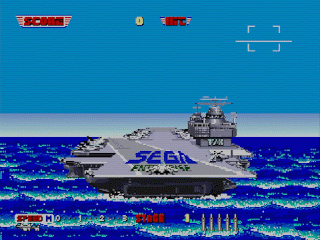
#gaming#arcade#sega#80s#afterburner#afterburner ii#afterburner 2#arcade games#retro gaming#aircraft#plane#jet#jet fighters#fighter jet#flight sim
16 notes
·
View notes
Text

Of course the Sabre was the most important Cold War aircraft, here’s why
Hush KitSeptember 27, 2022
The Cold War took a brief rest between the early 1990s and the 2010s, but serious tension between the largest former Soviet nation and the West has now returned. At the forefront of the original Cold War was air power, and this fearful age sired a multitude of incredible and often long-lived warplanes. In the second of a series of articles written by pilots and subject experts, we consider the question of which Cold War military aircraft was the most important. Let us turn start to Peter E Davies case for the F-86 Sabre.
In 1954 the massive Nellis Air Force Base in Nevada, later to host Red Flag and other spectacular USAF training activities and projects, was already an exciting place for new pilots. It hosted the F-86 Sabre, the world’s premier fighter at the time and one which became a seminal influence on most subsequent fighter designs. Sabre pilots had roundly defeated communist MiG-15s over North Korea, and many of those wartime pilots (including seventeen aces) were now instructors at Nellis. For new trainees the chance to join that exclusive fraternity was compelling. The Sabre’s reputation as the West’s first true jet dogfighter was well established. Before technology took over the combat cockpit it was also the last fighter in the tradition of the Spitfire and Mustang in which the pilot had full manual control. During the Cold War the Sabre and its pilots kept alive the dogfighting tradition at a time when caution and cost-cutting in training programs actually prevented many trainee pilots from indulging in realistic air combat manoeuvres. That continuity paved the route for a later generation of versatile air-fighters including the F-15 Eagle and F-16 Fighting Falcon. Conventional late-1950s wisdom advocated aerial combat with large aircraft firing missiles from long distances.
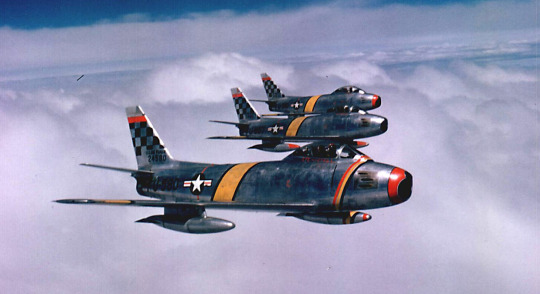
The Sabre’s outstanding combat record was founded in its design’s many technical advances at a time when most designers were still simply adding jet engines to WW II-style airframes. In 1943 North American Aviation (NAA), decided to avoid direct competition with Lockheed’s straight-winged F-80 Shooting Star, the USAF’s first successful jet fighter. The company initiated a new German-inspired wing in 1945, swept at 35 degrees. It was a bold step as the few previous swept-wing designs had exhibited instability problems. Large, automatic wing slats and hydraulically boosted ailerons were the innovative NAA solution, giving superb transonic handling. A unique blown plastic cockpit canopy gave all-round vision unequalled in fighters until the advent of the F-15 Eagle. NAA developed manufacturing techniques for a thin wing with machined-plate, double layer skins. The F-86E version introduced the now-universal powered, ‘all-flying’ tailplane.
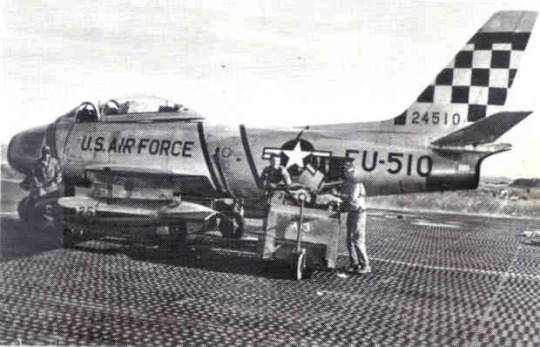
Sabres retained gun armament, either the standard six .50 calibre machine gun fit or (in later Sabres) 20mm cannon. Guns disappeared from many other Cold War fighters in favour of missiles, but the Vietnam war showed that to be a mistake. However, the Sabre also pioneered the use of air-to-air missiles in the radar-equipped, all weather, rocket firing F-86D version (added in 1949). It included an early afterburner and a complex Hughes E-4 fire-control system. It became the most prolific Sabre variant with over 2,500 manufactured, pioneering radar-based interception in many air forces of the Cold War era.
Early jet engines of the time were often unreliable, but NAA designers chose the best available option, the Allison J35 in the F-86 prototype which first flew on October 1, 1947 and achieved supersonic flight in a shallow dive the following year as the first service-capable fighter to achieve that speed safely. The engine was replaced by the General Electric J47, also selected for the B-47 Stratojet bomber. It became an outstanding powerplant in Korean combat and effectively proved that jet fighters could be as effective and reliable as their prop-driven predecessors – and a lot faster. Cold War fighter designers throughout the world benefited from that bonus.
When the Korean War began in June, 1950 the small Allied air forces in South Korea relied on WW II propeller-driven aircraft and early, straight-winged F-80 and F-84 jets. None matched the Soviet MiG-15, a broadly similar swept-wing jet to the Sabre. F-86As were urgently deployed to counter this unanticipated threat. Despite the MiG-15’s altitude advantage and its pilots’ proximity to their home bases the outnumbered, but better-trained Sabre pilots soon regained air superiority. It was a scenario to be repeated in many respects in Vietnam over a decade later.
The Sabre’s success and influence are demonstrated by its unusually widespread use. Overall production ran to almost 9,000 aircraft, with licence production in Canada, Japan, Italy and Australia. No fewer than 35 air forces used Sabres, making it the most numerous Western Cold War jet fighter and giving many of those users entry to the jet age. It equipped many NATO nations, including Great Britain, to face the growing Soviet threat following the Berlin crisis in 1949. Some continued in service, and occasional combat until the mid-1980s.The US Navy’s used F-86 derivatives, culminating in the very capable, long-range FJ-4B fighter-bomber. They equipped 22 USN and USMC squadrons up to 1962. In US Navy training sessions a well-flown F-86 regularly beat F-4 Phantom and F-8 Crusader pilots in dogfighting practices.
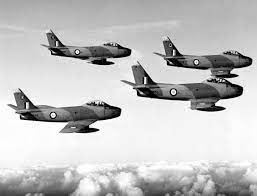
An F-86 pilot allegedly achieved supersonic flight shortly before Chuck Yeager’s official sound barrier-smashing flight in 1947, but it was the success rate of twelve-to-one against MiG-15s (later to be scaled down to a still creditable 4:1) that lent the Sabre an almost legendary status and reminded future fighter designers that manoeuvrability, ease of operation and gunfighting capability were still relevant in the supersonic era. While some might champion aircraft like the Hawker Hunter, F-4 Phantom or MiG-21 as the most influential Cold War fighters there is no doubt that the F-86’s wide range of ground-breaking achievements in design and worldwide service easily give it that accolade.

Peter E Davies. September 2022, Peter Davies is based in Bristol and has written or co-written 16 books on modern American combat aircraft, including four previous Osprey titles and the standard reference work on US Navy and Marine Corps Phantom II operations, Gray Ghosts.
39 notes
·
View notes
Note
The Marauder Bomber canonically can't take off on it's own
See, it's engines, well
4x J79-CS Afterburning Ramjet
And ramjets?
A ramjet, is a form of airbreathing jet engine that uses the forward motion of the engine to produce thrust. Since it produces no thrust when stationary (no ram air) ramjet-powered vehicles require an assisted take-off like a rocket assist to accelerate it to a speed where it begins to produce thrust.
Nevermind the fact it's capacity, 6,000lbs internal, 6,000lbs external, is less than the single engined A-7 Corsair II (15,000lbs)
TL:DR Games Workshop can't do maths OR engineering
While I greatly enjoy this physics lesson on aircraft, I feel we knew that. Not the maths bit, that’s cool to know, but the GW rule of cool over science bit. Like, this is a setting with mechanised walking megachurches. Shit would buckle under its own weight. But, seeing a church punch another, more spiky church in the nose is extremely fun
42 notes
·
View notes
Text

Lockeed's Mean Machines
#Lockheed Martin#Stealth Fighter#F-22#Raptor#F-35#Lightning II#Military aviation#combat aircraft#Fighter#5th Gen#afterburner#airshow
81 notes
·
View notes
Text

F-35 LİGHTNİNG II
77 notes
·
View notes